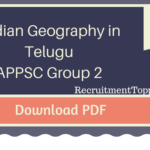APPSC |TSPSC Group 2 Paper I Indian Geography in Telugu Download PDF
https://www.youtube.com/watch?v=Ni2qKXMzCco
India is situated entirely on the Indian Plate, a major tectonic plate that was formed when it split off from the ancient continent Gondwanaland (ancient landmass, consisting of the southern part of the supercontinent of Pangea). The Indo-Australian plate is subdivided into the Indian and Australian plates. About 90 million years ago, during the late Cretaceous Period, the Indian Plate began moving north at about 15 cm/year (6 in/yr).About 50 to 55 million years ago, in the Eocene Epoch of the Cenozoic Era, the plate collided with Asia after covering a distance of 2,000 to 3,000 km (1,243 to 1,864 mi), having moved faster than any other known plate. In 2007, German geologists determined that the Indian Plate was able to move so quickly because it is only half as thick as the other plates which formerly constituted Gondwanaland.The collision with the Eurasian Plate along the modern border between India and Nepal formed the orogenic belt that created the Tibetan Plateau and the Himalayas
Click on the Links to Download PDFs
- భారతదేశ ద్వీపకల్ప నదీ వ్యవస్థ
- భారతదేశ హిమాలయ నదీ వ్యవస్థ
- మృత్తికలు – రకాలు
- భారతదేశ తీర మైదానాలు – దీవులు
- ద్వీపకల్ప భారతదేశం – నైసర్గిక స్వరూపం
- హిమాలయపర్వత వ్యవస్థ – ప్రాధాన్యం
- ఎడారులు – పవన క్రమక్షయం
- భారతదేశం – ఖనిజాలు
- దేశంలో దుర్భిక్షానికి కారణాలు
- పారిశ్రామిక మండలాలు
- భారతదేశం – పరిశ్రమలు
- శిలలు
- ప్రధాన రేవు పట్టణాలు
- మృత్తికలు
- భారతదేశం- ఇంధన వనరులు
- భారతదేశ అటవీ సంపద
- జనాభా
- భారతదేశం – శీతోష్ణస్థితి
- భారతదేశం- భూ స్వరూపాలు
- భారతదేశంలో రవాణా
- భారతదేశం – బహుళార్థ సాధక ప్రాజెక్టులు

